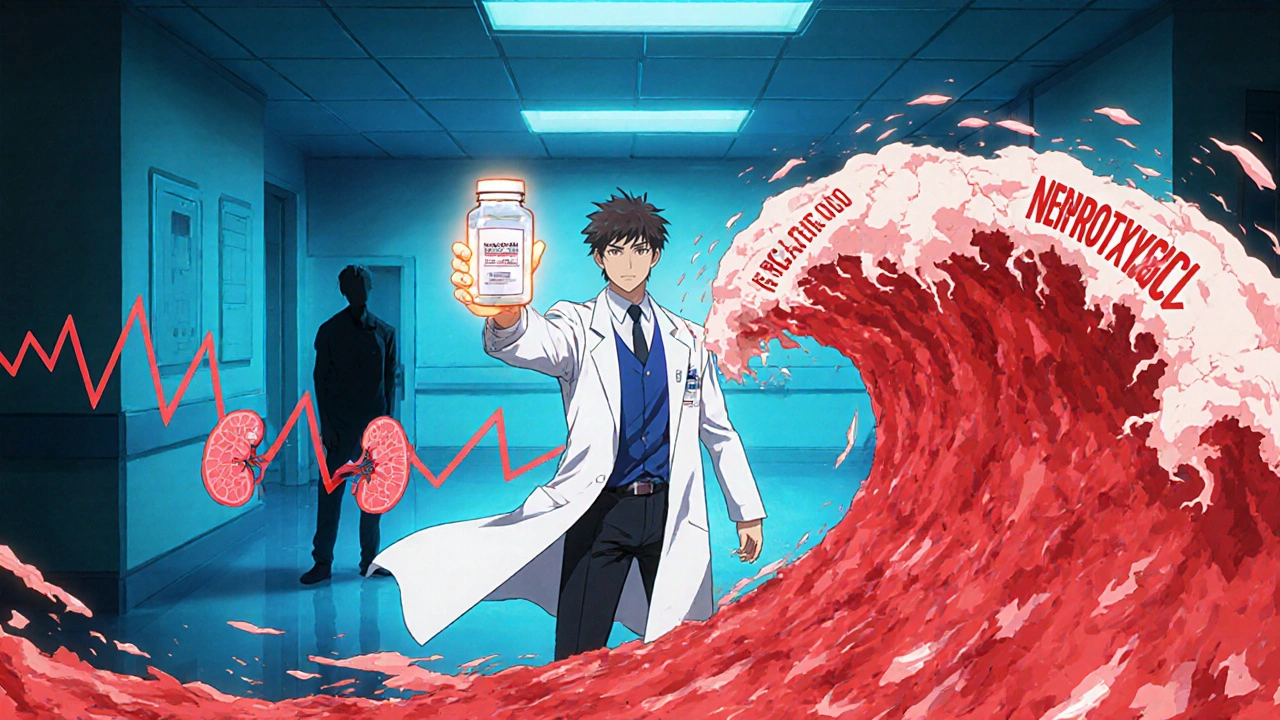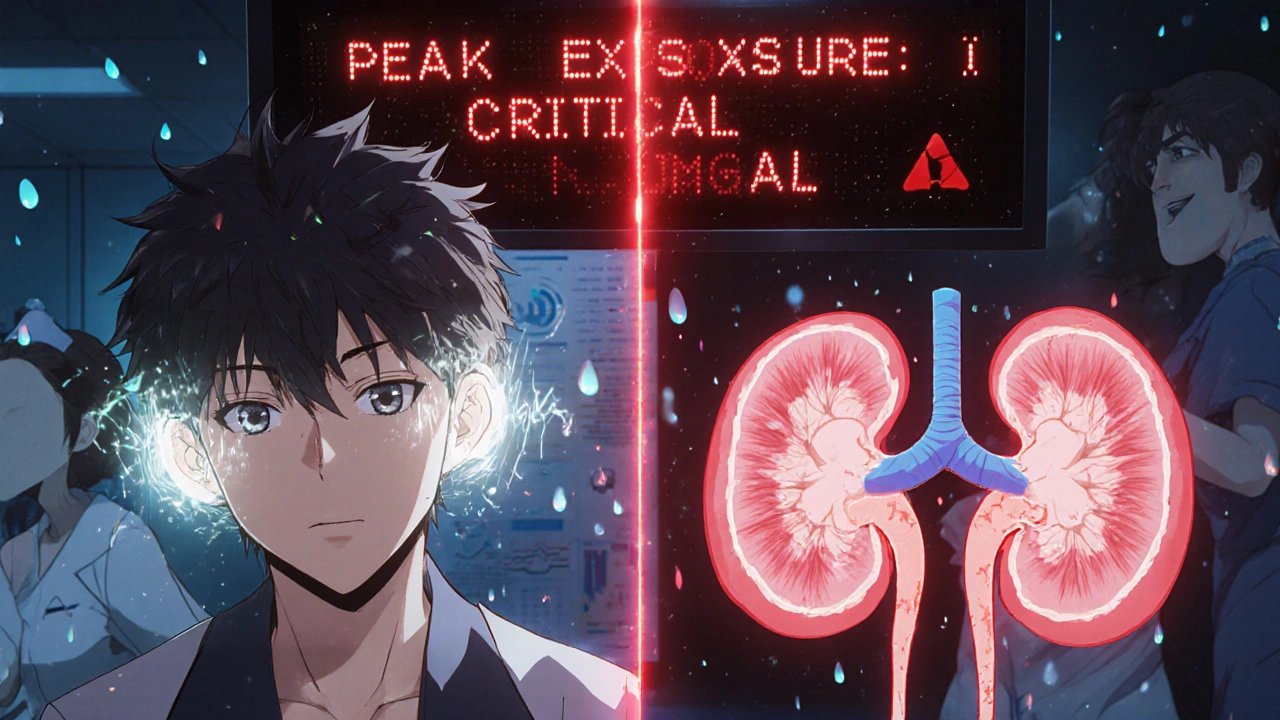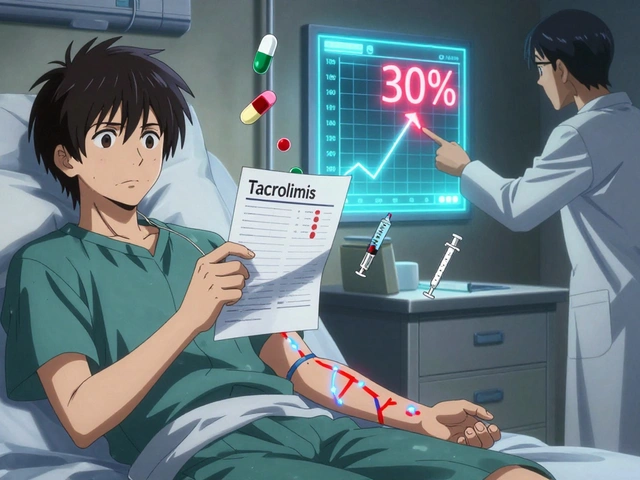
Vancomycin Risk Assessment Tool
Assess Vancomycin Toxicity Risk
This tool calculates risk of nephrotoxicity and ototoxicity based on clinical factors from evidence-based guidelines. Enter values as shown and click "Calculate".
Risk Assessment Results
Nephrotoxicity Risk
Ototoxicity Risk
Vancomycin saves lives. It’s the go-to antibiotic for deadly infections like MRSA, especially when other drugs fail. But for every patient it helps, there’s a real chance it could harm their kidneys or hearing - sometimes permanently. The question isn’t whether vancomycin is dangerous. It’s whether you’re watching for the right signs at the right time.
Why Vancomycin Still Matters - Even With Its Risks
Vancomycin isn’t new. It’s been around since the 1950s. Back then, it was messy. Impure batches caused kidney damage in more than half the patients. Today’s version is cleaner, but the risks haven’t disappeared. They’ve just changed shape.Now, vancomycin is used for serious infections: sepsis, endocarditis, bone infections, and hospital-acquired pneumonia. It’s often the only option left when bacteria laugh at penicillin, cephalosporins, or even carbapenems. That’s why doctors keep prescribing it - even when they know the downsides.
Here’s the hard truth: if you don’t use vancomycin when it’s needed, patients die. But if you use it carelessly, you might leave them with permanent hearing loss or kidney damage that requires lifelong dialysis. The goal isn’t to avoid vancomycin. It’s to use it smartly.
Nephrotoxicity: The Common, Often Reversible Threat
Nephrotoxicity - kidney damage - is the most frequent problem with vancomycin. Between 5% and 30% of patients develop it, depending on how you measure it and what else they’re taking.The biggest red flag? Combining vancomycin with piperacillin-tazobactam. Studies show this combo increases the risk of acute kidney injury by more than double compared to vancomycin with meropenem. It’s not just a minor interaction. It’s a clinical trap many hospitals still fall into.
Other risk factors pile up fast:
- Trough levels above 15-20 mcg/mL
- Daily doses over 4 grams
- Treatment longer than 7 days
- Pre-existing kidney problems
- Older age or critical illness
Damage usually shows up between days 3 and 14. Creatinine levels creep up. Urine output drops. Sometimes, it’s subtle - a 0.3 mg/dL rise in creatinine is enough to count as kidney injury under modern guidelines. Most cases are reversible if caught early. But if you wait too long, the damage can become permanent.
Monitoring is simple but often skipped. Check creatinine every 48 to 72 hours. If it climbs, pause vancomycin. Don’t wait for it to hit 2.0 or 3.0. That’s too late.
Ototoxicity: The Silent, Irreversible Danger
Ototoxicity - hearing damage - is rarer. Only 1% to 3% of patients experience it. But when it happens, it’s devastating.Unlike kidney damage, there’s no reliable blood test. No creatinine spike. No urine drop. You won’t know until the patient says, “I can’t hear my grandkids anymore.”
It usually starts with high-frequency hearing loss - the kind you don’t notice until you’re struggling in noisy rooms or can’t hear birds chirping. Tinnitus often comes with it. The damage is bilateral, sensorineural, and usually permanent.
Here’s what’s scary: ototoxicity can happen even with normal trough levels. A 2023 case report showed hearing loss after just three doses - in a patient with perfectly healthy kidneys. Another case in 1981 proved it could happen without any kidney trouble at all. That shattered the old myth that ototoxicity only occurs in people with poor renal function.
Some studies link it to peak concentrations above 80 mcg/mL, but others show damage at levels as low as 40 mcg/mL. The real issue? Individual susceptibility. Some people’s inner ear cells are just more sensitive. Genetic factors, like variants in the MT-RNR1 gene, can make someone 3 times more likely to lose hearing on vancomycin.
There’s no early warning system. Audiograms can catch it - but only if you do them. And most hospitals don’t. Only 37% have formal ototoxicity monitoring protocols. The rest rely on patients reporting symptoms - too late.

Why Monitoring Troughs Alone Isn’t Enough
For decades, doctors watched vancomycin trough levels - the lowest concentration in the blood before the next dose. The old target was 15-20 mcg/mL. That’s changed.The 2020 ASHP guidelines now recommend 10-15 mcg/mL for most infections. Why? Because above 15 mcg/mL, kidney damage risk shoots up - but effectiveness doesn’t improve. You’re just increasing harm without gaining benefit.
But here’s the twist: trough levels don’t predict ototoxicity well. A patient with a perfect 12 mcg/mL trough can still lose hearing. Why? Because ototoxicity is tied to peak levels and total exposure time, not just the bottom of the curve.
That’s why AUC (area under the curve) monitoring is gaining ground. Instead of measuring one point, you track the total drug exposure over time. Hospitals using AUC-guided dosing cut nephrotoxicity rates from nearly 15% down to under 9%. That’s a 40% drop.
But AUC monitoring needs software, training, and time. Only 68% of hospitals use it. Many still rely on outdated trough-only checks - and miss the real danger.
Combination Therapy: The Hidden Killer
Vancomycin rarely travels alone. It’s often paired with beta-lactams like piperacillin-tazobactam, especially in ICU patients with sepsis.This combo is popular because it covers a wide range of bacteria. But it’s also the single biggest risk factor for kidney injury. The 2022 meta-analysis of over 14,000 patients found V+PT increased AKI risk by 131% compared to V+M.
Here’s the irony: even though V+PT causes more kidney damage, it doesn’t improve survival. Patients die at the same rate whether they get V+PT or V+M. So you’re adding toxicity without added benefit.
Some hospitals now use electronic alerts to flag V+PT combinations. Those that did saw usage drop by 22%. That’s a win. But many still don’t have them. And when they do, clinicians often override them - because they’re afraid of under-treating.
Ask yourself: Is this patient really at risk for Pseudomonas? Or are you just covering bases? If not, consider alternatives like meropenem, cefepime, or even ceftaroline - especially if kidney function is already shaky.
Who Needs Extra Monitoring - And Who Doesn’t
Not everyone needs the same level of caution. Risk stratification matters.High-risk patients:
- Age 65+
- Pre-existing hearing loss or kidney disease
- Receiving vancomycin with other ototoxic or nephrotoxic drugs (aminoglycosides, NSAIDs, contrast dye)
- On high doses (>4g/day) or long courses (>7 days)
- ICU patients with septic shock
For these people:
- Baseline audiogram before starting vancomycin
- Weekly audiograms if treatment lasts longer than a week
- AUC monitoring if available
- Strict trough targets: 10-15 mcg/mL, never above 20
- Renal function checked every 48 hours
Low-risk patients: Young, healthy, short course (<5 days), no other kidney or ear drugs, normal renal function.
For them, routine audiograms aren’t cost-effective. But you still need creatinine checks every 72 hours. Don’t skip them.
Cost-benefit analysis shows audiograms only make sense for high-risk groups. For others, the cost per quality-adjusted life year saved is over $47,000. That’s not practical in most hospitals.

What to Do When Toxicity Shows Up
If creatinine rises more than 0.3 mg/dL from baseline, or if a patient reports ringing in the ears or muffled hearing - act fast.For nephrotoxicity:
- Stop vancomycin if possible
- Check for other nephrotoxins and discontinue them
- Hydrate - but don’t overdo it
- Monitor urine output and electrolytes
- Most patients recover kidney function within days to weeks
For ototoxicity:
- Stop vancomycin immediately
- Refer for urgent audiometry
- Document the hearing loss - it’s permanent
- Consider hearing aids or cochlear implants if damage is severe
- There’s no reversal. Prevention is the only treatment
Never wait for symptoms to worsen. Once hearing is gone, it doesn’t come back.
The Future: Better Tools, Smarter Dosing
New tools are emerging. The 2023 VAN-GUARD trial showed real-time AUC monitoring cut nephrotoxicity in half. Platforms like DoseMeRx and PrecisePK use algorithms to predict risk before it happens - with 86% accuracy.Genetic testing is on the horizon. If you know a patient has the MT-RNR1 gene variant, you might avoid vancomycin entirely - or use a lower dose with tighter monitoring.
Point-of-care audiometers are being developed. Imagine a handheld device that checks hearing in 5 minutes at the bedside. That could change everything.
But until then, the best tools are still the oldest: vigilance, communication, and knowing when to stop.
Final Thought: It’s Not About Avoiding Vancomycin - It’s About Mastering It
Vancomycin isn’t going away. It’s too effective. Too vital. But we’ve become too comfortable with it. We think because it’s old, it’s safe. We think because it’s common, it’s harmless.It’s not.
The difference between a patient who recovers and one who loses their hearing or needs dialysis often comes down to one thing: whether someone was watching closely enough.
Don’t just prescribe vancomycin. Monitor it. Question it. Challenge the combo. Adjust the dose. Listen to the patient. Because sometimes, the most dangerous thing about vancomycin isn’t the drug itself - it’s our assumption that we’ve already tamed it.
Can vancomycin cause hearing loss even if kidney function is normal?
Yes. While vancomycin ototoxicity was once thought to only occur in patients with kidney impairment, case reports since the 1980s - including a 2023 report in Cureus - have documented sudden hearing loss in patients with perfectly normal kidney function. This suggests individual susceptibility, possibly due to genetic factors like MT-RNR1 variants, plays a major role. Trough levels alone cannot predict this risk.
What vancomycin trough level is considered safe?
The 2020 ASHP guidelines recommend a trough of 10-15 mcg/mL for most infections. Troughs above 15 mcg/mL significantly increase the risk of nephrotoxicity without improving effectiveness. For complex infections like endocarditis or osteomyelitis, a target of 15-20 mcg/mL may still be used - but only with close monitoring and clear justification.
Is vancomycin + piperacillin-tazobactam always dangerous?
Not always, but it’s one of the highest-risk combinations for kidney injury. Studies show it increases acute kidney injury risk by over 130% compared to vancomycin with meropenem. If the patient doesn’t have a clear risk for Pseudomonas, consider alternatives like cefepime or ceftaroline. If you must use the combo, monitor creatinine every 24-48 hours and be ready to switch.
How often should kidney function be checked during vancomycin therapy?
Serum creatinine should be checked at baseline and every 48-72 hours during therapy. For high-risk patients - those over 65, with pre-existing kidney disease, or on high doses - check every 24 hours. Don’t wait for a dramatic spike. A rise of 0.3 mg/dL or more from baseline meets the definition of acute kidney injury.
Should all patients get audiograms before taking vancomycin?
No. Routine audiograms are not cost-effective for low-risk patients. They’re recommended only for high-risk individuals: those over 65, with pre-existing hearing loss, on prolonged therapy (>7 days), receiving high doses (>4g/day), or on other ototoxic drugs. For these groups, baseline and weekly audiograms can catch early changes before damage becomes permanent.
Write a comment
Your email address will not be published.





11 Comments
Vancomycin is such a double-edged sword lol
Let me be clear: if you're not monitoring AUC, you're not practicing medicine-you're gambling. And piperacillin-tazobactam combos? That's not clinical judgment, that's laziness with a side of arrogance. We've known this for years. Stop pretending it's a mystery.
The fact that 68% of hospitals still use troughs alone is a national disgrace. We're not in the 1980s. We have the tech. We have the guidelines. We have the data. What we don't have is the will to change.
And don't get me started on the audiograms. You think a patient is going to say, 'Hey doc, I can't hear my grandkids anymore'? No. They'll just stop answering the phone. Then you find out six months later they're depressed, isolated, and your 'successful' treatment left them deaf.
It's not about cost. It's about competence. If you can't afford to do AUC monitoring, you shouldn't be giving vancomycin. Period. End of story.
And yes-I'm talking to you, ICU teams who think 'covering everything' means 'throwing everything at the wall.' You're not saving lives. You're just delaying the inevitable.
The MT-RNR1 gene variants? That's not theoretical. I've seen it. Two patients. Same dose. Same trough. One deaf. One fine. Genetics isn't a footnote-it's the headline.
Stop treating vancomycin like it's penicillin. It's not. It's a sledgehammer with a trigger that doesn't always reset. And if you don't treat it like that, you're not a doctor-you're a statistic waiting to happen.
And yes, I'm angry. Because I've seen the charts. I've seen the hearing tests. I've seen the dialysis referrals. And I know-without a shadow of a doubt-that most of it was preventable.
Excellent breakdown. The AUC data is compelling, and the piperacillin-tazobactam risk is grossly underappreciated in practice. I've advocated for institutional protocols since 2021, but resistance remains stubborn. Many clinicians still believe 'if it's not broken, don't fix it'-even when the data screams otherwise.
One addition: the 2023 Canadian guidelines now recommend baseline audiometry for all patients receiving >7 days of vancomycin, regardless of risk. It’s a small step, but it’s a step forward.
Thank you for this. As a clinical pharmacist, I’ve spent years pushing for AUC monitoring, and the resistance is often cultural, not clinical. Many providers think 'we've always done it this way'-but we've also always had preventable hearing loss and AKI.
One practical tip: if your hospital doesn’t have AUC software, use the Bayesian estimator in the Vancomycin Dosing Assistant app. It’s free, FDA-cleared, and reduces nephrotoxicity by 30% even without full TDM.
And yes-stop the V+PT combo unless Pseudomonas is confirmed or highly suspected. The mortality data doesn’t support it. The toxicity data does.
This is exactly why we need more pharmacist-led stewardship programs. I work in a rural hospital in India, and we don’t have AUC monitoring-but we do have trained pharmacists checking daily creatinine, reviewing drug interactions, and flagging high doses before they become problems.
We also educate nurses to ask patients daily: 'Can you hear me clearly?' It sounds simple, but it catches early tinnitus. We’ve prevented two cases of permanent hearing loss this year alone just by asking.
It’s not about fancy tech. It’s about attention. And that’s something every hospital, everywhere, can afford.
Vancomycin is powerful. But power without discipline is destruction.
Check creatinine. Avoid V+PT unless necessary. Listen to the patient. That’s all.
Interesting how the article ignores the economic disincentives. AUC monitoring requires software licenses, staff training, and IT support. Hospitals that are already underfunded can’t afford it. So they default to troughs. It’s not negligence-it’s survival.
And let’s be honest: most patients don’t care about hearing loss until it’s too late. They want the infection gone. The system rewards speed over safety.
This isn’t a clinical failure. It’s a structural one.
This made me so emotional. I had a cousin who lost her hearing after vancomycin for sepsis. She was 28. Healthy. No kidney issues. Just… gone. One day she was laughing, the next she couldn’t hear her dog bark. No one warned us. No one asked. I wish someone had read this before she got it.
Please, if you’re prescribing this-just ask. Just check. Just care.
💙
hearing loss is silent until its too late
we treat kidneys like they’re replaceable but ears? nope
we need to change that
Vancomycin is a mirror. It reflects our priorities. Do we value efficiency over ethics? Speed over silence? Survival over sensation? We optimize for survival because death is visible. Hearing loss is invisible. So we ignore it. Until it’s too late. Until someone whispers, I can’t hear you anymore. And then we feel guilty. But we don’t change. We just move on to the next patient.
The real toxicity isn’t in the drug. It’s in our indifference.
As a physician practicing in a resource-limited setting, I deeply appreciate this nuanced discussion. While advanced monitoring like AUC remains aspirational in many regions, the principles of vigilance, dose limitation, and clinical awareness are universally applicable. We may not have software, but we have eyes, ears, and a duty to listen-not just to labs, but to patients. A simple question-'Can you hear me now?'-can change a life. Let us not wait for perfect tools to practice imperfectly compassionate care.